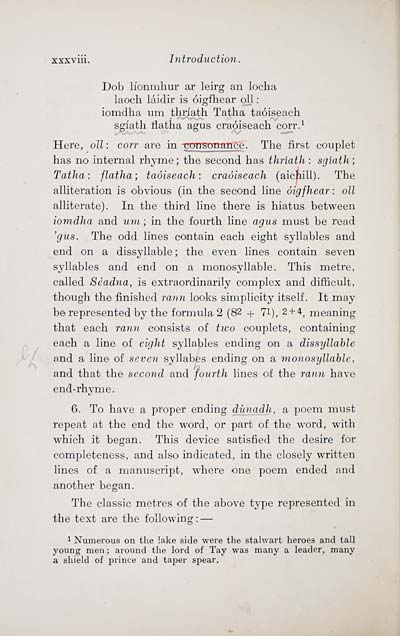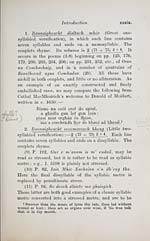Download files
Complete book:
Individual page:
Thumbnail gallery: Grid view | List view

xxxviii. Introduction .
Dob lioumhur ai- leirg an locha
laoch laidir is òigfhear oll :
iomdha um tliria.th Tatha taòiseach
sgiath flatiia agus craòiseach corr.^
Here, oll: corr are in - caus onance. The first couplet
has no internal rhyme; the seeond has thriath : sgìath;
Tatha: flatha; taòiseach: craòiseach (aicpill). The
alliteration is obvious (in the second Hne òigfhear : oll
alHterate). In the third line there is hiatus between
iomdha and uni ; in the fourth Hne agus must be read
'gus. The odd lines contain each eight syHables and
end on a dissyllable; the even Hnes contain seven
syllables and end on a monosyHable. This metre,
caHed Sèadna, is extraordinarily complex and difficult,
tho-ugh the finished rann looks simplicity itself. It may
be represented by the formula 2 (82 + 71), 2 + 4, meaning
that each ranìi consists of tivo couplets, containing
each a Hne of eight syllables ending on a dissyllable
and a line of seven syllabes ending on a monosyllable,
and that the second and foiirth lines of the rann have
end-rhyme.
6. To have a proper ending dùnadh, a poem must
repeat at the end the word, or part of the word, with
which it began. This device satisfied the desire for
completeness, and also indicated, in the closely written
lines of a manuscript, where one poem ended and
another began.
The classic metres of the above type represented in
the text are the following : —
1 Numerous on the lake side were the stalwart heroes and tall
young men; around the lord of Tay was many a leader, many
a shield of prince and taper spear.
Dob lioumhur ai- leirg an locha
laoch laidir is òigfhear oll :
iomdha um tliria.th Tatha taòiseach
sgiath flatiia agus craòiseach corr.^
Here, oll: corr are in - caus onance. The first couplet
has no internal rhyme; the seeond has thriath : sgìath;
Tatha: flatha; taòiseach: craòiseach (aicpill). The
alliteration is obvious (in the second Hne òigfhear : oll
alHterate). In the third line there is hiatus between
iomdha and uni ; in the fourth Hne agus must be read
'gus. The odd lines contain each eight syHables and
end on a dissyllable; the even Hnes contain seven
syllables and end on a monosyHable. This metre,
caHed Sèadna, is extraordinarily complex and difficult,
tho-ugh the finished rann looks simplicity itself. It may
be represented by the formula 2 (82 + 71), 2 + 4, meaning
that each ranìi consists of tivo couplets, containing
each a Hne of eight syllables ending on a dissyllable
and a line of seven syllabes ending on a monosyllable,
and that the second and foiirth lines of the rann have
end-rhyme.
6. To have a proper ending dùnadh, a poem must
repeat at the end the word, or part of the word, with
which it began. This device satisfied the desire for
completeness, and also indicated, in the closely written
lines of a manuscript, where one poem ended and
another began.
The classic metres of the above type represented in
the text are the following : —
1 Numerous on the lake side were the stalwart heroes and tall
young men; around the lord of Tay was many a leader, many
a shield of prince and taper spear.
Set display mode to: Large image | Transcription
Images and transcriptions on this page, including medium image downloads, may be used under the Creative Commons Attribution 4.0 International Licence unless otherwise stated. ![]()
| Early Gaelic Book Collections > Matheson Collection > Bardachd Ghaidhlig > (42) |
|---|
| Permanent URL | https://digital.nls.uk/76423023 |
|---|
| Description | Specimens of Gaelic poetry 1550-1900. |
|---|---|
| Shelfmark | Mat.50 |
| Additional NLS resources: | |
| Attribution and copyright: |
|
| Description | Items from a collection of 170 volumes relating to Gaelic matters. Mainly philological works in the Celtic and some non-Celtic languages. Some books extensively annotated by Angus Matheson, the first Professor of Celtic at Glasgow University. |
|---|
| Description | Selected items from five 'Special and Named Printed Collections'. Includes books in Gaelic and other Celtic languages, works about the Gaels, their languages, literature, culture and history. |
|---|

